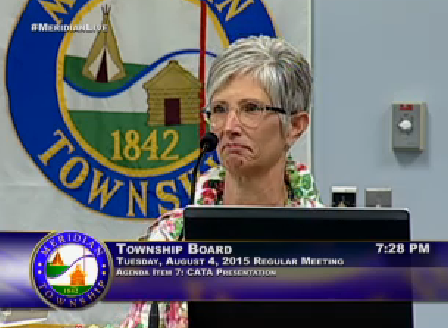CATA Updates Meridian Township On BRT Project
- Published: 8/5/2015
- Comments
MERIDIAN TOWNSHIP - During the August 4th Township Board meeting, Capital Area Transportation Authority (CATA) Assistant Executive Director Debbie Alexander presented an update of the Bus Rapid Transit (BRT) project. The BRT would run from the foot of the Capitol Building to Marsh Road and offer a quick, easy transportation system for the anticipated population growth, which was illustrated in the Tri-County Regional Planning Commission's (TCRPC) 25-year plan.
Alexander announced that CATA has made it through the alternative analysis process and has submitted an Environmental Assessment (EA) report to the Federal Transit Administration, which is currently under review. CATA hopes to have a public hearing sometime this Fall with a decision of environmental clearance by December. If cleared, Alexander says that the final design and engineering stages will begin in January of next year with hopes to begin construction in 2017 and opening day in 2018.
According to an illustration that was shown during the meeting, the corridor would begin by going clockwise around the Capitol building and then continue east on Grand River Ave. Interestingly, the corridor would run in the opposite direction of current traffic flow. However, Alexander said the reason they're doing this is because MDOT and the City of Lansing asked CATA not to put infrastructure in place that would prevent them from going to two lane roadway on both Grand River Ave. and Capitol Ave.
Alexander went on to discuss their method for transportation modeling in which they used information from the TCRPC 25-year plan (i.e., population, job and traffic growth) and brought it down to the corridor area. Alexander also provided traffic count data that was collected from April and September of last year, as well as compared traffic data by day of week during those same time periods.
Currently, the BRT's total construction cost is $155 million, which is $40 million less than the original plan; however, Alexander said that CATA will continue to look for ways to bring those costs down. About $3.5 million has already been spent on design and engineering with $9 million left to spend, making the total cost for the BRT about $167.5 million.
CATA's Route 1 (which runs between Michigan Ave. and Grand River Ave.) constantly being at or above capacity during peak hours has been an ongoing issue and leading factor for the BRT.
"We can solve this problem by ourselves, by simply adding more vehicles to the route, but what we've learned through this process is that that doesn't solve the problem for the transportation network, and in fact, we actually cause more problems for the auto capacity in the laneage. So, what we're trying to do is put forward a transportation network that works and adds capacity both in the auto lanes, and for the future, growth," said Alexander. "Our goal in the transportation arena is to maximize the number of people or the number of belly buttons that we can get through the corridor, not the number of number of automobiles or vehicles of any kind. So, what we're trying to do is provide a way forward for the next 25-35 years."
Route 1 currently has 45 stops that are about 1-1.5 blocks apart. However, instead of using traditional stops, Alexander said the BRT would allow passengers to board the bus at a station instead. A total of 28 stations would be placed throughout the BRT.
Other improvements would include passengers making all payments at the station rather than on the bus. The BRT would also use a docking system to limit the space between the bus floor and the station, making it easier and safer for passengers to board. Electronic signs would be placed at each station making it easier for passengers to know when the next bus will arrive. Additionally, passengers would be able to store their bikes along the wall inside the bus instead of outside on the front of the bus.
Another feature of the BRT is that it will be equipped with signal priority. For example, if the bus is approaching a green light, then the light will stay green long enough for the bus to pass through. If the bus is approaching a red light, the red light will advance to green. This signal priority feature will allow a faster transit, providing an overall travel advantage for passengers.
According to Alexander, all of these changes combined would reduce the boarding time from 2.5 minutes (and sometimes 5 minutes depending on the number of passengers boarding) to less than one minute.
"We've now added capacity back into the auto lanes, because we've removed buses stopping every 10 minutes (in the auto lanes)... so, we've actually improved the capacity in the lanes that are remaining. We've also improved capacity on the bus line, because now it's in its own lane and we can add as many buses as we need with 100-120 people capacity per bus... because it's not interfering with any other vehicles (that are) operating, we're actually maximizing the capacity of the infrastructure through this strategy."
In addition, the BRT would require adding new medians. According to the Federal Highway Administration, medians reduce auto accidents by 40 percent and pedestrian accidents by 46 percent. Medians also reduce delays from slowing traffic to make left turns by 30 percent, and increase property values by 7 percent due to the presence of the median and the beautification it can bring to a community.
At the end of the presentation, Board members expressed their appreciation and concerns for the updated plan, including Township Clerk Brett Dreyfus who asked about parking issues and where passengers can park their cars before boarding the BRT. Alexander replied by saying that CATA is planning on having 1 or 2 Park and Ride lots around the Marsh Road area (one at Meridian Mall and one at Meijer). Alexander explained that those coming from the North can park at the mall and those coming from the South can park at Meijer. Alexander also said a second area is planned to be around US-127.


 Spanish
Spanish Chinese (Simplified)
Chinese (Simplified) Korean
Korean French
French German
German Hindi
Hindi Urdu
Urdu Japenese
Japenese Arabic
Arabic Russian
Russian Farsi
Farsi
